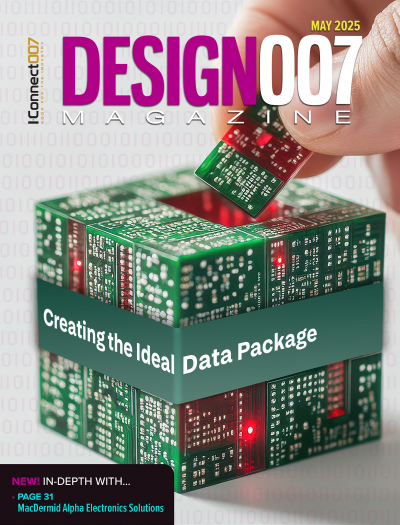-

-
News
News Highlights
- Books
Featured Books
- design007 Magazine
Latest Issues
Current Issue
All About That Route
Most designers favor manual routing, but today's interactive autorouters may be changing designers' minds by allowing users more direct control. In this issue, our expert contributors discuss a variety of manual and autorouting strategies.

Creating the Ideal Data Package
Why is it so difficult to create the ideal data package? Many of these simple errors can be alleviated by paying attention to detail—and knowing what issues to look out for. So, this month, our experts weigh in on the best practices for creating the ideal design data package for your design.

Designing Through the Noise
Our experts discuss the constantly evolving world of RF design, including the many tradeoffs, material considerations, and design tips and techniques that designers and design engineers need to know to succeed in this high-frequency realm.
- Articles
- Columns
- Links
- Media kit
||| MENU - design007 Magazine
Living in a Material World: High-Speed Design Strategies
January 13, 2022 | I-Connect007 Editorial TeamEstimated reading time: 5 minutes
Any discussion about high-speed PCB design techniques would be incomplete without considering the properties and requirements of the materials. Your material selection drives much of your design strategy when you’re operating at 28 gigabits per second or faster.
We recently spoke with high-speed design expert Lee Ritchey of Speeding Edge, and electronic materials veteran Tarun Amla of Avishtech and Thintronics, about the relationship between advanced PCB materials and high-speed design techniques. They discuss the challenges facing designers and engineers working with materials at speeds that were considered unreachable not long ago, and what designers need to know about material selection as board speeds continue rising toward the stratosphere.
Andy Shaughnessy: Would you set the stage by explaining the last few decades of materials that got us to where we are now and how designers are having to learn these EM properties?
Lee Ritchey: I joined 3COM in 1996 where we were doing reasonably well making all the lengths work at 10 megabits per second. And then I got started working on 100 megabits, and that was thought to be pretty fast. At that point, the only thing we were worried about was reflections and crosstalk, which basically meant impedance. In the laminates, we worried about whether we could get repeatability on impedance with a cross-section. And by 1998, I helped a startup build us a product where we had the links leaving the box at a gigabit per second. That was thought to be magical, and of course it was, in that context.
It wasn’t very long before I went to a startup called Procket Networks, where all the internal signals were 3.125 gigabits per second, and that was where we first started to worry about things like loss. Until then we hadn’t worried much about any of those properties. We worried about losses because the transceiver sets were not very good, so they couldn’t tolerate much. For example, a 10 dB loss was a big number, and so that’s when we started driving the laminate manufacturers to reduce loss. At the time, the only material that was considered low-loss was Nelco 4000-13 SI, and they achieved it by using a low-loss glass. That worked just fine until the tsunami happened in Japan, and Nittobo, the one supplier of that glass, was inside the quarantine zone. Within a week none of us could build our products anymore because we were all single-sourced with that glass.
I got involved with Isola to see if we could do something about it. It wasn’t too long before we were doing 10 gigs, and it surprised me that we soon were doing 100 gigs. The current links, the undersea cables all around the world, are 400 gigabits per second, which is pretty astonishing. We are achieving that with eight links of 56 gigabits per second, which pushed every single thing about the laminates. The industry wants us to double that, and to do that we’re using PAM4 (pulse-amplitude modulation), a four-level coating so that the clock is still 28 gigahertz. For us, the loss problem is still the same, but the noise margin, because the levels are smaller, is such that the error rate is not good enough right now. This is where I’m pushing material, now that we know the industry is going to want that.
Between 1996 and 2021, we went from 10 megabits per second to 400 gigabits. That’s a 40,000X increase in bandwidth in 25 years. To do that we have pushed everything about the laminate. Tarun is probably the most renowned at doing that because he’s been the major player driving that whole thing. There are two things that I worry about. One is skew, which is glass weave that causes the two sides of the differential pair to not arrive at the same time, and then the link won’t work. The other is loss. Tarun, you can pick up the ball.
Tarun Amla: I remember around 2002 where people said that five gigabits per second was going to be unattainable in copper. There was a lot of work done around using optical channels which did not get much traction. Around that time, the RoHS lead-free legislation was coming on board, and that just added another layer of complexity, because not only did you want these signals to go through at those high data rates, but you also wanted reliable performance. Boards now had to go through 6X reflow at 260?C for qualifications. In some cases, the qualification standards are about 10X reflow or even higher. Now I’m hearing about 20X reflow, which seems weird. Why would you want to do that to your board?
We are at a crossroads where we have to look at the next generation. Sadly, finding an alternative for copper is going to be difficult with the amount of work involved. A materials—dielectric—solution has to come through, or it will be like what happened with Moore’s Law. We are at an impasse because we have reached the limits, especially with 112 gigabits per second. If you’re trying to do it with PAM4, like Lee said, the margins are lower and you’ve got this inherent skew in that signaling, so that’s where it stands. The whole industry is waiting, and whether it’s 5G or 112 gigabits per second, the stage is set for something new to happen.
Happy Holden: The people I worked with in Taiwan making the flip chip substrates have been doing 8- to 15-micron lines as a basis for almost the last 15 years. Although they use a BT core and BT prepreg, they never got very good yields once they got under 20 microns, until they switched to using the Ajinomoto build-up film. Today, all eight of the Asian manufacturers of high-density packages use the ABF material primarily because it’s a very well-engineered resident system that’s robust, but it goes down extremely flat. That planarity is required for high density of imaging and developing, as well as etching. So, 20 microns is considered about the best you can do if you use laminate and prepreg. Below that and you have to start going to these engineered liquids or films that the Japanese perfected initially, and now other sources are available for them. That’s true for the thin film.
To read this entire conversation, which appeared in the January 2022 issue of Design007 Magazine, click here.
Suggested Items
The Evolution of Picosecond Laser Drilling
06/19/2025 | Marcy LaRont, PCB007 MagazineIs it hard to imagine a single laser pulse reduced not only from nanoseconds to picoseconds in its pulse duration, but even to femtoseconds? Well, buckle up because it seems we are there. In this interview, Dr. Stefan Rung, technical director of laser machines at Schmoll Maschinen GmbH, traces the technology trajectory of the laser drill from the CO2 laser to cutting-edge picosecond and hybrid laser drilling systems, highlighting the benefits and limitations of each method, and demonstrating how laser innovations are shaping the future of PCB fabrication.
Day 2: More Cutting-edge Insights at the EIPC Summer Conference
06/18/2025 | Pete Starkey, I-Connect007The European Institute for the PCB Community (EIPC) summer conference took place this year in Edinburgh, Scotland, June 3-4. This is the third of three articles on the conference. The other two cover Day 1’s sessions and the opening keynote speech. Below is a recap of the second day’s sessions.
Day 1: Cutting Edge Insights at the EIPC Summer Conference
06/17/2025 | Pete Starkey, I-Connect007The European Institute for the PCB Community (EIPC) Summer Conference took place this year in Edinburgh, Scotland, June 3-4. This is the second of three articles on the conference. The other two cover the keynote speeches and Day 2 of the technical conference. Below is a recap of the first day’s sessions.
Preventing Surface Prep Defects and Ensuring Reliability
06/10/2025 | Marcy LaRont, PCB007 MagazineIn printed circuit board (PCB) fabrication, surface preparation is a critical process that ensures strong adhesion, reliable plating, and long-term product performance. Without proper surface treatment, manufacturers may encounter defects such as delamination, poor solder mask adhesion, and plating failures. This article examines key surface preparation techniques, common defects resulting from improper processes, and real-world case studies that illustrate best practices.
RF PCB Design Tips and Tricks
05/08/2025 | Cherie Litson, EPTAC MIT CID/CID+There are many great books, videos, and information online about designing PCBs for RF circuits. A few of my favorite RF sources are Hans Rosenberg, Stephen Chavez, and Rick Hartley, but there are many more. These PCB design engineers have a very good perspective on what it takes to take an RF design from schematic concept to PCB layout.


